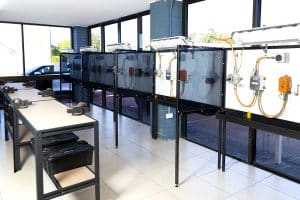More About Roar Solutions
More About Roar Solutions
Blog Article
Roar Solutions for Dummies
Table of ContentsAbout Roar Solutions5 Easy Facts About Roar Solutions DescribedRoar Solutions Things To Know Before You Buy
In such an ambience a fire or surge is possible when three basic problems are fulfilled. This is usually referred to as the "unsafe area" or "combustion" triangle. In order to secure setups from a possible surge an approach of analysing and identifying a possibly dangerous area is called for. The objective of this is to make certain the appropriate selection and installation of equipment to ultimately stop a surge and to guarantee security of life.
(https://profiles.delphiforums.com/n/pfx/profile.aspx?webtag=dfpprofile000&userId=1891249800)
No equipment must be installed where the surface temperature of the equipment is better than the ignition temperature level of the provided risk. Below are some usual dirt dangerous and their minimum ignition temperature level. Coal Dirt 380C 225C Polythene 420C (thaws) Methyl Cellulose 420C 320C Starch 460C 435C Flour 490C 340C Sugar 490C 460C Grain Dirt 510C 300C Phenolic Material 530C > 450C Aluminium 590C > 450C PVC 700C > 450C Residue 810C 570C The likelihood of the danger existing in a focus high sufficient to create an ignition will certainly differ from area to location.
In order to classify this risk an installment is separated right into locations of risk relying on the amount of time the dangerous is existing. These locations are described as Zones. For gases and vapours and dusts and fibers there are 3 zones. Area 0 Area 20 A dangerous environment is highly likely to be existing and may be present for extended periods of time (> 1000 hours each year) and even continually Zone 1 Zone 21 A dangerous atmosphere is possible yet not likely to be present for long periods of time (> 10 450 C [842 F] A classification of T6 suggests the minimal ignition temperature is > 85 C [185 F] Dangerous location electrical devices maybe made for usage in higher ambient temperature levels. This would indicated on the ranking plate e.g. EExe II C T3 Ta + 60C( This indicates at 60C ambient T3 will not be gone beyond) T1 T1, T2, T3, T4, T5, T6 T2 T2, T3, T4, T5, T6 T3 T3, T4, T5, T6 T4 T4, T5, T6 T5 T5, T6 T6 T6 A T Class ranking of T1 indicates the maximum surface area temperature level generated by the tool at 40 C is 450 C. Assuming the connected T Class and Temperature rating for the equipment are suitable for the location, you can always use an instrument with a much more rigid Department score than needed for the area. There isn't a clear solution to this concern regrettably. It actually does depend upon the sort of devices and what repair services require to be accomplished. Tools with specific test treatments that can not be done in the field in order to achieve/maintain third celebration rating. Need to come back to the manufacturing facility if it is prior to the devices's solution. Field Repair By Authorised Worker: Complex screening may not be needed nonetheless particular treatments might need to be complied with in order for the tools to keep its 3rd party ranking. Authorized personnel need to be used to execute the work properly Repair service additional info must be a like for like replacement. New element should be taken into consideration as a straight replacement requiring no special screening of the tools after the repair is complete. Each item of equipment with an unsafe rating should be assessed separately. These are laid out at a high degree listed below, but also for more comprehensive info, please refer straight to the standards.
The Buzz on Roar Solutions
The tools register is a comprehensive database of tools records that consists of a minimum collection of fields to recognize each product's place, technical parameters, Ex lover classification, age, and ecological data. The ratio of In-depth to Shut assessments will certainly be figured out by the Tools Threat, which is examined based on ignition danger (the chance of a resource of ignition versus the likelihood of a flammable environment )and the dangerous area category
( Zone 0Area 1, or 2). Implementing a durable Risk-Based Assessment( RBI )strategy is crucial for making certain compliance and safety and security in taking care of Electrical Tools in Hazardous Areas( EEHA).
Getting My Roar Solutions To Work

In regards to eruptive danger, an unsafe area is an environment in which an eruptive environment is present (or might be anticipated to be existing) in quantities that call for special preventative measures for the building and construction, setup and use devices. electrical refresher course. In this post we explore the challenges encountered in the work environment, the risk control actions, and the needed expertises to function securely
These materials can, in certain conditions, form eruptive ambiences and these can have significant and terrible effects. Many of us are familiar with the fire triangle get rid of any one of the three aspects and the fire can not take place, however what does this mean in the context of unsafe locations?
In a lot of instances, we can do little about the levels of oxygen in the air, yet we can have significant impact on sources of ignition, for instance electrical tools. Harmful locations are recorded on the harmful area classification drawing and are determined on-site by the triangular "EX" indication. Right here, amongst various other key information, zones are divided right into 3 kinds relying on the threat, the chance and period that an explosive ambience will certainly exist; Zone 0 or 20 is deemed one of the most dangerous and Area 2 or 22 is considered the least.
Report this page